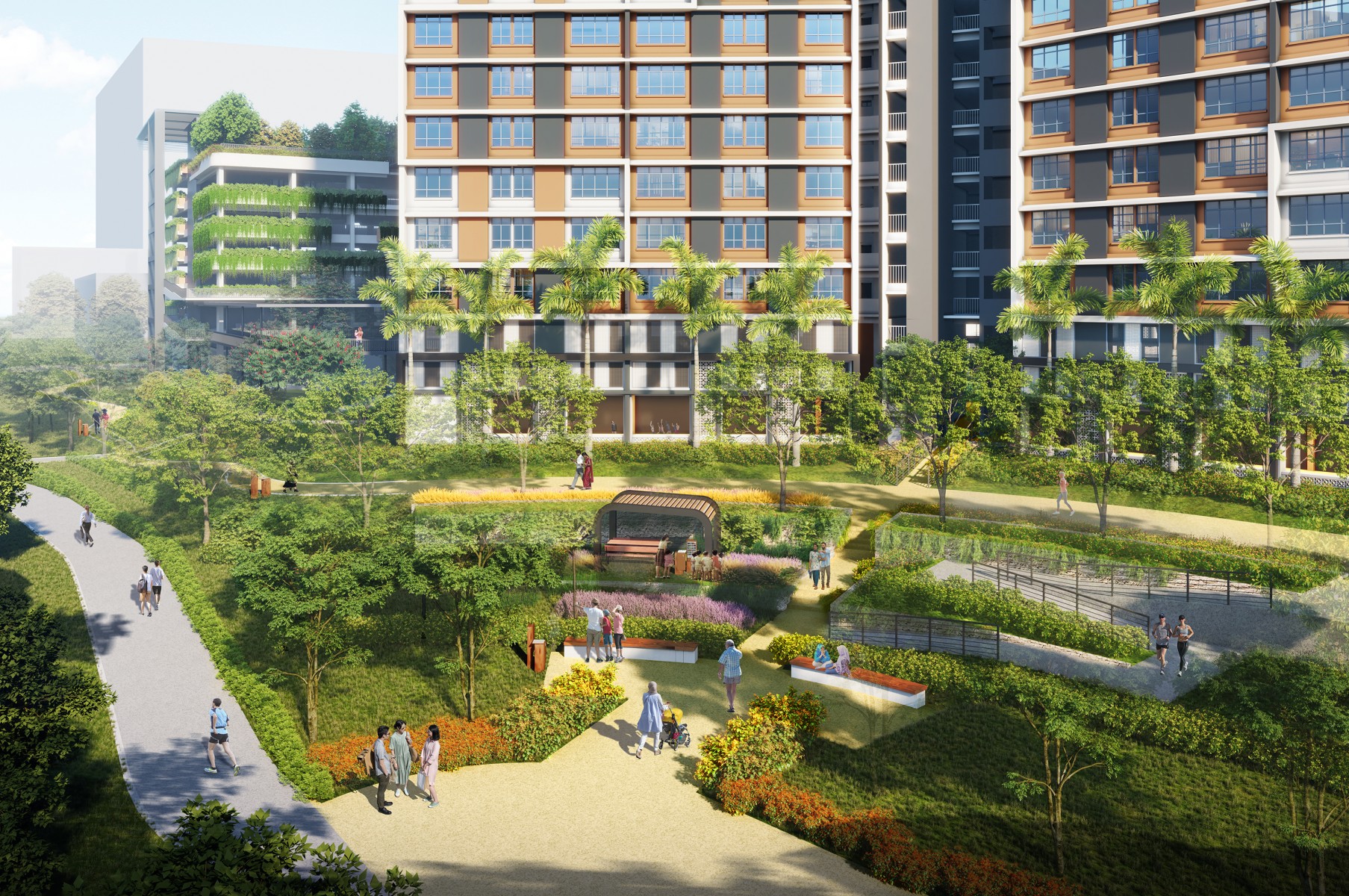
Residents of Queenstown can look forward to quality homes and a living environment that will support their physical, social, and mental well-being, to enable them to lead more active and fulfilling lives. The Housing & Development Board (HDB), the National University Health System (NUHS) and the National University of Singapore (NUS), together with multiple stakeholders from the public, private and people sectors, will be embarking on a first-of-its-kind collaboration to develop the Health District @ Queenstown pilot (please refer to Annex A for a list of some of the partnering agencies). Minister for National Development, Mr Desmond Lee, announced the plans for the Health District @ Queenstown at the HDB Awards ceremony today.
We will leverage the broad range of expertise of our partners to create integrated solutions to enhance the health and well-being of residents across their life stages. We will do this primarily via two ways – more integrated planning and design of Queenstown informed by scientific evidence, and community-driven programmes – to support residents in leading healthier and more productive lives.
The Health District @ Queenstown is overseen by the Minister of State for National Development, and Communications and Information, Mr Tan Kiat How, together with Parliamentary Secretary, Ministry of Health, and Ministry of Communications and Information, Ms Rahayu Mahzam, and Parliamentary Secretary, Ministry of Culture, Community and Youth, and Ministry of Social and Family Development, Mr Eric Chua.
An International Advisory Panel, chaired by Dr John Rowe of Columbia University, has also been appointed to advise the Health District Steering Committee on meaningful outcomes to achieve the goals of the Health District based on international benchmarks and best practices. Please refer to Annex B for the list of International Advisers.
Selection of Queenstown for the Health District Pilot
First developed in the 1950s by the Singapore Improvement Trust and subsequently by HDB, Queenstown is Singapore’s first satellite town. Over the years, we have introduced several rejuvenation programmes to ensure that the town can keep pace with residents’ evolving needs and aspirations. This time, we will focus our rejuvenation efforts on enhancing residents’ health and well-being.
Health District @ Queenstown is bounded by the following roads: Tanglin Road / Alexandra Road to the east, Harbour Drive to the south, Clementi Road to the west & North Buona Vista Road / Ridout Road / Kay Siang Road to the north.
Queenstown has been selected as the pilot site for the Health District as its demographics closely mirror Singapore’s projected national demographics by year 2030. The town currently has one of the oldest populations in Singapore, with almost one out of every four Singaporeans aged 65 and above. Together with various upcoming development and rejuvenation plans for Queenstown, there are opportunities to pilot interventions for better well-being of residents, promote health-seeking behaviours, and encourage social connections.
Objectives for Health District @ Queenstown
The objectives of the Health District @ Queenstown are to:
- Promote healthy longevity – To increase residents’ health span, i.e. the time residents spend in good health for as long as possible.
- Enable purposeful longevity – Purposeful living, whereby individuals pursue their interests and are able to actively contribute to areas such as work, family and community, is expected to have positive health benefits and may potentially increase longevity.
- Promote intergenerational bonding – Intergenerational bonding is expected to improve brain and physical function among older adults, as well as improve literacy skills and social development among children. It also promotes greater social cohesion in the community and a greater sense of purpose.
- Enable a community of all ages – By enabling residents to be independent and to age-in-place, they can continue to be in familiar company and surroundings.
The Health District @ Queenstown will focus on four key areas to achieve its objectives:
i) Preventive Health and Care Delivery
Encourage uptake of preventive health recommendations and shift care delivery from hospital to or near residents’ homes
|
ii) Purposeful Longevity |
Enable purposeful longevity by providing opportunities for residents to work, volunteer and participate in lifelong learning |
|
iii) Planning and Design |
Implement planning and design solutions to support ageing in place, social and mental well-being, and for an active lifestyle |
|
iv) Technology |
Co-design affordable technological solutions with the community to improve residents’ lives |
The initial list of programmes that will be pursued in the Health District are listed in the paragraphs that follow. More programmes will be added subsequently.
(i) Preventive Health and Care Delivery
NUHS will implement an enhanced My Health Map programme to improve residents’ access to preventive health services by bringing health screenings on-site to residents where appropriate and conducting health talks within the community. Care coordinators will also actively reach out to residents, working closely with partners such as Lions Befrienders, the Agency for Integrated Care and the People’s Association, to help residents navigate the healthcare system. Eligible residents will be also invited to join the SINgapore GERiatric Intervention Study to Reduce Cognitive Decline and Physical Frailty (SINGER), which seeks to reduce the risk of cognitive impairment and dementia.
Developed by NUHS, My Health Map is a preventive health management plan that empowers residents to stay healthy. In line with the Ministry of Health, it recommends age appropriate health screening and vaccinations. These preventive health milestones are based on age and gender guidelines and include cancer screening, chronic disease screening (diabetes, hypertension, hyperlipidaemia), functional screening, frailty screening, and pneumococcal and influenza vaccinations.
(ii) Purposeful Longevity
To enable us to design and implement appropriate programmes and schemes, residents will be invited to share their perceptions of what and how they envision purposeful engagement to be. There will also be courses to equip residents with skills and knowledge to live a purposeful life, starting with NUS’ ‘Designing for a 100-Year Life’ course, that is scheduled to commence before the end of 2021. (Course registration link: https://nus.edu/3jhXDIo)
(iii) Planning and Design
To create a healthy town for all ages, HDB will develop solutions that address residents’ functional needs across different life cycle stages. This will be backed by medical and social science and data. In line with HDB’s ‘Designing for Life’ roadmap, which places the holistic well-being of residents at its core, we will anticipate future needs and develop initiatives to enhance residents’ physical, social, and mental well-being:
(a) Physical Well-Being: In planning and designing the built environment, HDB will place greater emphasis on solutions that can encourage residents to lead active lifestyles and improve their physical well-being.
For example, Queen’s Arc, a BTO development launched in Queenstown in August 2021, has been planned with good connectivity to the nearby Rail Corridor, where residents can enjoy a variety of recreational activities. The development is also close to the future Alexandra hospital campus, providing residents with better access to healthcare services.
Within the multi-storey development, a jogging loop at the car park rooftop garden as well as attractively designed staircases, will encourage residents to incorporate exercise into their daily routines. Residents can also exercise along the wellness trail and heritage walk while appreciating the heritage of the area.
Roof garden spaces can also be transformed to urban farming spaces, to encourage residents to spend more time outdoors, while a pedestrian mall with wellness-themed amenities and flexible spaces, can be adapted to hold health-related events and programmes. Please refer to Annex C for more details on the Queen’s Arc project.
Apart from new housing projects, existing neighbourhoods are also enhanced through the Neighbourhood Renewal Programme (NRP), in consultation with residents. For example, residents’ feedback has been incorporated into the plans for the upcoming NRP at Commonwealth Avenue. Resting areas will be provided along the covered linkways to allow residents to rest and recharge, while additional fitness stations will be introduced to motivate residents to adopt an active lifestyle. We will continue to work with residents on future NRP projects in the town.
(b) Social Well-Being: Another key goal is to promote social well-being by designing community spaces to facilitate interactions among residents and encouraging bonding across all generations.
For instance, in the development of new housing areas such as Ulu Pandan, green and blue elements will be incorporated to enhance local biodiversity while also promoting residents’ well-being. Residents will be able to enjoy seamless access to the Green Corridor along the Ulu Pandan canal, which comprises a linear park with a wider park connector, creating more opportunities for community interaction and recreational activities.
(c) Mental Well-Being: HDB recognises that engaging the mind and creating tranquil places for relaxation can greatly benefit our residents and improve overall quality of life.
SkyParc @ Dawson, for example, has been planned and designed within a scenic park-like setting, in line with the Housing-in-a-Park concept for Dawson estate. Residents can enjoy green views at every turn, with more than 80 species of trees, palms and scrubs interspersed throughout the strategically positioned sky terraces, roof gardens, as well as landscaped common greens at the ground level. They can also immerse themselves in the Dawson Community Eco-corridor – a 200m pedestrianised corridor where 18 mature trees have been conserved. Specially designed nest boxes and drilled wood logs hang from these mature trees, recreating the natural habitats of birds and insects. Together with the native tropical plantings that have been introduced, these trees provide the foundation to enhance the vegetation and retain the vibrant array of wildlife in the area, while offering residents opportunities for a contemplative and rejuvenating experience.
More tranquil green spaces will be provided within precincts in other parts of Queenstown under our various rejuvenation efforts, so residents can enjoy the restorative benefits of nature.
(iv) Technology
We also aim to co-create affordable and useable technology to improve residents’ lives, starting with solutions co-developed with residents, caregivers, and family/community support networks. We will partner with industry to test-bed and deploy relevant technology which allows people to remain independent, assists in disease prevention, and improves healthcare delivery.
A Long-term Project with Potential to Scale Initiatives to Other Parts of Singapore
We will collaborate with various stakeholders, including residents, to formulate solutions that can enhance the physical, social, and mental well-being of residents. As infrastructure projects and the improvement of health outcomes require time, the Health District is intended as a long-term project that will take many years to realise its full potential. We remain committed to enhancing the well-being of residents through good design and community programmes that can be implemented sustainably and scaled across Singapore to meet the evolving needs of our population.
Joint NUS, HDB and NUHS Press Release









